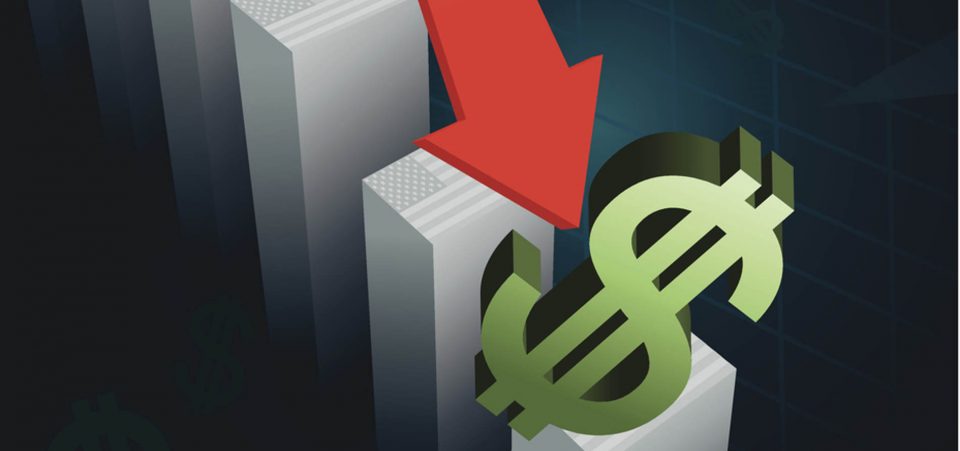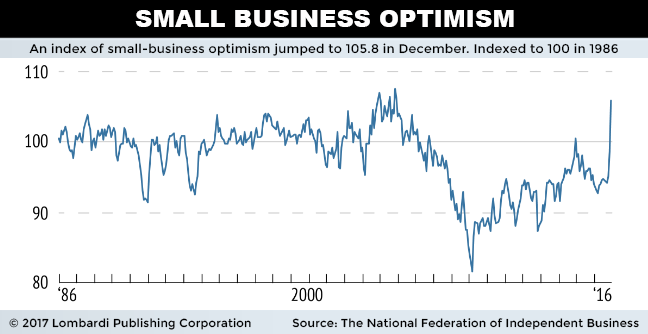Analyst Issues Dramatic Warning in U.S. Dollar Forecast for 2017
This U.S. dollar forecast for 2017 promises excessive downward dollar pressure, as bearish dynamics win out over the more positive aspects of the current administration’s pro-growth agenda. While President Donald Trump is a central player in the coming calamity, he is far from the only catalyst. Macro events will overshadow U.S. Federal Reserve policies this time around.
Early foreshadowing of the likely volatility which lies ahead occurred just after the election of Donald Trump. After touching one-month lows a week before the U.S. presidential election, the dollar proceeded to rally 7.29% less than two months after the election. This elevated the U.S. Dollar Index out of its two-year trading range between 92 and 100. Put another way, the dollar rallied almost as much in two months as it had for the two years prior.
It’s likely that the initial strength of the dollar was related to the expected pro-growth agenda that Trump had been touting for months. For currency traders, his campaign slogan, “Make America Great Again,” was like an open invitation to long the dollar hand-over-fist. Policies which would make the aforementioned slogan a reality—narrowing (or reversing completely) U.S. trade deficits, bringing back jobs, repatriating trillions of dollars of foreign-held capital abroad, higher-trend gross domestic product (GDP), et al—are all dollar-supportive.
But this has only masked the sleeping bear, which is about to emerge from hibernation.
To get a sense of how palpable business enthusiasm is post-Obama, the National Federation of Independent Business (NFIB) quantifies it for us. The NFIB’s index on small business sentiment soared by 7.4 points in December 2016 to 105.8, up from November’s reading of 98.4. This was the largest month-over-month gain since the index was created 20 years ago. (Source: “Small-business optimism soars after Trump election,” CNBC, January 10, 2017.)
Overall, small-business sentiment reached its highest aggregate level since 2004, owing to a perceived improvement in business conditions. Sales expectations increased by 20 percentage points, and the percentage of owners who believe now is the right time to expand elevated 12 points. (Source: Ibid.)
There’s also dollar-supportive measures expected to emanate from the Federal Reserve in the coming months. As of this writing, Bloomberg’s World Interest Rate Probability has forecast a 100% probability of an interest rate hike for the upcoming Federal Open Market Committee (FOMC) meeting, while current odds are favoring two additional rate hikes in 2017.
If these dollar-supportive measures existed in a vacuum, the U.S. dollar exchange rate and U.S. dollar forecast for 2017 maybe could have remained stable. But, alas, as Isaac Newton once said, for every action, there is an equal and opposite reaction. This is especially the case with Trump, with which one iteration of fiscal policy doesn’t necessarily jive with the next.
The “opposite reaction(s)” I’m specifically referring to are deficit spending and trade. For all the good that the administration’s domestic economic agenda may bring to America, it will also need financing. With the nation’s official government debt set to exceed $20.0 trillion in March, the can is going to get a little more dented. The U.S. government, in part with the Federal Reserve, will need to issue more Treasury Securities even as the Fed attempts to reduce its balance sheet.
As large deficits relative to GDP have a weakening effect on the currency, it will be interesting to see if the Federal Reserve can issue longer-dated securities to avoid paying back the principal for a lifetime. Treasury Secretary Steven Mnuchin has suggested that future Treasury issuance could be extended to as long as 50 or 100 years. (Source: “Steven Mnuchin Roils Bond Markets With Suggestion Of 100 Year Treasury Bond,” Zero Hedge, November 30, 2016.)
Much of the dollar forecast for 2017 will also rest on Mnuchin’s handling of the upcoming debt ceiling debacle. This seems to be a new semi-annual crisis dogging America. Only in 2017, with the Trump administration looking to juice deficit spending even more, this year’s deadline looms even larger.
A failure to reach an agreement on the new debt ceiling in 2017 will put the nation in default mode and send the dollar careening lower. Mnuchin will do everything he can to bring all parties together to hammer out a workable solution, but will Trump’s enemies (even within his own party) seek to irrevocably damage his presidency by failing to pass a debt ceiling resolution in 2017?
And, even if they do, how much time left does this can-kicking exercise have to run? The U.S. debt is already north of $20.0 trillion, with unfunded liabilities 12 times that total. Higher inflation looks likely, and Trump’s words and actions as a real estate mogul all point to further deficit spending.
U.S. Dollar Forecast for 2017
While most traders have generally focused on the positives since the outset of the election, most of the weak-dollar scenarios will only uncover themselves as time passes. Traders usually focus on the rhetoric first, because it’s what’s in the news cycle first. The problem is that now, if Trump’s pro-growth agenda falls flat, the dollar has nowhere to go but down. And this is before the decidedly negative impacts of trade wars kick in.
Take trade, for example. Trump, along with Secretary of State Rex Tillerson, has been openly antagonistic of China on trade, currency manipulation, and South Sea Island claims. China has pushed back in an offensive way, and the climate is such that there’s little room for retreat from both countries’ entrenched positions. One can easily envision huge effects on bilateral trade between both countries, which would affect the U.S. dollar forecast for 2017 dramatically.
The big question du jour, of course, is how such a trade war would play out. Would it be a garden variety tit-for-tat affair, with only peripheral industries affected? Or would large-scale multinationals bear the brunt of tariffs and import restrictions? This matters because the scale of Sino-American trade relations is enormous. An estimated $659.4 billion in U.S. goods and services trade with China changed hands in 2015.
And while the massive $347.0 billion trade deficit with China in 2016 is not helpful for dollar strength, the recycling of China trade surpluses into U.S. Treasuries is. Although the Chinese have been net sellers of U.S. Treasuries in recent months, the ship will have permanently sailed if huge U.S. trade surpluses banked in previous years come to a grinding halt. Taking some of the biggest buyers of Treasuries out of the market is poignantly dollar-negative.
Then we have recent jawboning coming from the administration, which raises questions on their desire to maintain a strong dollar policy. In fact, it’s downright dollar-negative.
Although President Trump didn’t use the words exactly, he’s basically called for a de facto weakening of the U.S. dollar by pressuring key exporting countries to strengthen their currencies. Trump recently vowed to include a clause prohibiting currency manipulation in any future bilateral trade agreements. He has also vowed to call China a “currency manipulator” while his trade advisers have said that Germany is adopting a “grossly undervalued” euro to exploit U.S. and European Union (EU) partners. (Source: “Dollar: Trump Jawboning vs. Fed Tightening,” FXStreet, January 31, 2017.)
By pressuring other countries to boost their currencies, Trump is hoping that foreign leaders will do the heavy lifting for him. Doing so could allow U.S. manufacturers to better compete on price without having to resort to weakening the dollar himself, thus potentially stoking inflation. However, doing so comes with the risk of unpredictable outcomes which are impossible to quantify until they happen.
If the administration slaps tariffs on Chinese goods, for example, these actions would invite backlash. China would surely take the U.S. to World Trade Organization (WTO) court to obligate the U.S. to own up to commitments made in the past. The WTO oversees the rules of global commerce and trade, and the enforcement of such.
China has a track record of retaliating in trade disputes. In one example, China lashed back against the United States by taxing U.S. chicken parts in 2009 after the Barack Obama administration slapped tariffs on Chinese tire imports. China’s English-language newspaper Global Times, published by the ruling Communist Party, has put forth that “China will take a tit-for-tat approach” if punitive tariffs of up to 45% on Chinese imports are enforced. (Source: “China for ‘tit-for-tat’ if Donald Trump wages trade war: Chinese media,” Deccan Chronicle, November 14, 2016.)
Total Trade, U.S. Imports & Exports (2015)
(Source: “United States: Trade Statistics,” globalEDGE, last accessed March 13, 2017.)
| Total Exports | $1,503,870,438,318 |
|---|---|
| Total Imports | $2,306,822,161,269 |
| Trade Balance | -$802,951,722,951 |
| Exports of Goods and Services (% of GDP) | 12.55% |
| Imports of Goods and Services (% of GDP) | 15.45% |
Regardless of what happens, the last thing that the price-sensitive U.S. consumer needs is the import inflation resulting from a global trade war. But these are the types of consequences that can arise when “jawboning” escalates into something more insidious. This will have negative consequences for the U.S. dollar forecast for 2017 because of either higher inflation resulting from tariffs, or a battering of GDP due to reduced trade.
USD Currency Forecast
The initial dollar-supportive rhetoric looks to have reeled some people in. The euphoria has affected some investors, raising the internal U.S. dollar forecast for 2017 expectations for some. This is to be expected; rhetoric is always the first thing to hit the news cycle, and platitudes emanating from Washington are always rainbows and unicorns.
However, the growling bear is about to make a comeback once policy reality sets in. A multitude of factors can portend a U.S. dollar collapse, from protectionist intentions to soaring deficits to seeping inflation above trend growth. In this cycle, a couple of interest rate hits won’t forestall the declines. The dyke is bursting, and there’s not enough fingers holding the raging waters back.
Readers should ask themselves this: if Trump is really to achieve his stated three-to-four-percent GDP growth target over the next few years, how is a much weaker USD currency not possible? There’s exactly zero chance that this figure will be achieved on the backs of a debt-ridden and tapped-out domestic consumer. It will need to be partially export-driven, and a much weaker dollar will need to be part of that equation.
Rainbows and unicorns don’t await the U.S. dollar forecast for 2017, but rather, a swamp monster ready to devour the dollar on any administration missteps.







